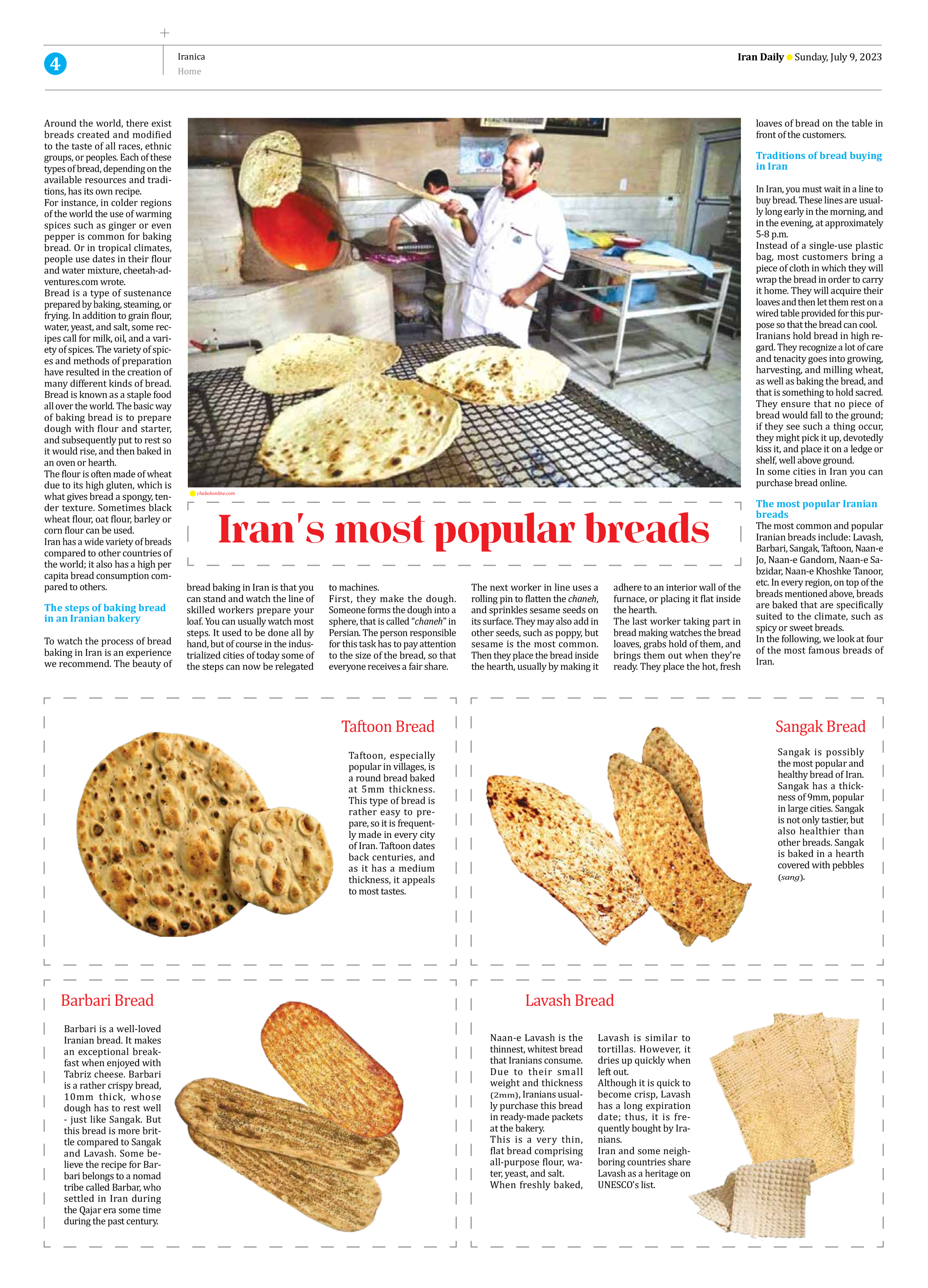
Iran’s most popular breads
Around the world, there exist breads created and modified to the taste of all races, ethnic groups, or peoples. Each of these types of bread, depending on the available resources and traditions, has its own recipe.
For instance, in colder regions of the world the use of warming spices such as ginger or even pepper is common for baking bread. Or in tropical climates, people use dates in their flour and water mixture, cheetah-adventures.com wrote.
Bread is a type of sustenance prepared by baking, steaming, or frying. In addition to grain flour, water, yeast, and salt, some recipes call for milk, oil, and a variety of spices. The variety of spices and methods of preparation have resulted in the creation of many different kinds of bread. Bread is known as a staple food all over the world. The basic way of baking bread is to prepare dough with flour and starter, and subsequently put to rest so it would rise, and then baked in an oven or hearth.
The flour is often made of wheat due to its high gluten, which is what gives bread a spongy, tender texture. Sometimes black wheat flour, oat flour, barley or corn flour can be used.
Iran has a wide variety of breads compared to other countries of the world; it also has a high per capita bread consumption compared to others.
The steps of baking bread in an Iranian bakery
To watch the process of bread baking in Iran is an experience we recommend. The beauty of bread baking in Iran is that you can stand and watch the line of skilled workers prepare your loaf. You can usually watch most steps. It used to be done all by hand, but of course in the industrialized cities of today some of the steps can now be relegated to machines.
First, they make the dough. Someone forms the dough into a sphere, that is called “chaneh” in Persian. The person responsible for this task has to pay attention to the size of the bread, so that everyone receives a fair share.
The next worker in line uses a rolling pin to flatten the chaneh, and sprinkles sesame seeds on its surface. They may also add in other seeds, such as poppy, but sesame is the most common. Then they place the bread inside the hearth, usually by making it adhere to an interior wall of the furnace, or placing it flat inside the hearth.
The last worker taking part in bread making watches the bread loaves, grabs hold of them, and brings them out when they’re ready. They place the hot, fresh loaves of bread on the table in front of the customers.
Traditions of bread buying in Iran
In Iran, you must wait in a line to buy bread. These lines are usually long early in the morning, and in the evening, at approximately 5-8 p.m.
Instead of a single-use plastic bag, most customers bring a piece of cloth in which they will wrap the bread in order to carry it home. They will acquire their loaves and then let them rest on a wired table provided for this purpose so that the bread can cool.
Iranians hold bread in high regard. They recognize a lot of care and tenacity goes into growing, harvesting, and milling wheat, as well as baking the bread, and that is something to hold sacred. They ensure that no piece of bread would fall to the ground; if they see such a thing occur, they might pick it up, devotedly kiss it, and place it on a ledge or shelf, well above ground.
In some cities in Iran you can purchase bread online.
The most popular Iranian breads
The most common and popular Iranian breads include: Lavash, Barbari, Sangak, Taftoon, Naan-e Jo, Naan-e Gandom, Naan-e Sabzidar, Naan-e Khoshke Tanoor, etc. In every region, on top of the breads mentioned above, breads are baked that are specifically suited to the climate, such as spicy or sweet breads.
In the following, we look at four of the most famous breads of Iran.
Sangak Bread
Sangak is possibly the most popular and healthy bread of Iran. Sangak has a thickness of 9mm, popular in large cities. Sangak is not only tastier, but also healthier than other breads. Sangak is baked in a hearth covered with pebbles (sang).
Taftoon Bread
Taftoon, especially popular in villages, is a round bread baked at 5mm thickness. This type of bread is rather easy to prepare, so it is frequently made in every city of Iran. Taftoon dates back centuries, and as it has a medium thickness, it appeals to most tastes.
Lavash Bread
Naan-e Lavash is the thinnest, whitest bread that Iranians consume. Due to their small weight and thickness (2mm), Iranians usually purchase this bread in ready-made packets at the bakery.
This is a very thin, flat bread comprising all-purpose flour, water, yeast, and salt.
When freshly baked, Lavash is similar to tortillas. However, it dries up quickly when left out.
Although it is quick to become crisp, Lavash has a long expiration date; thus, it is frequently bought by Iranians.
Iran and some neighboring countries share Lavash as a heritage on UNESCO’s list.
Barbari Bread
Barbari is a well-loved Iranian bread. It makes an exceptional breakfast when enjoyed with Tabriz cheese. Barbari is a rather crispy bread, 10mm thick, whose dough has to rest well - just like Sangak. But this bread is more brittle compared to Sangak and Lavash. Some believe the recipe for Barbari belongs to a nomad tribe called Barbar, who settled in Iran during the Qajar era some time during the past century.







